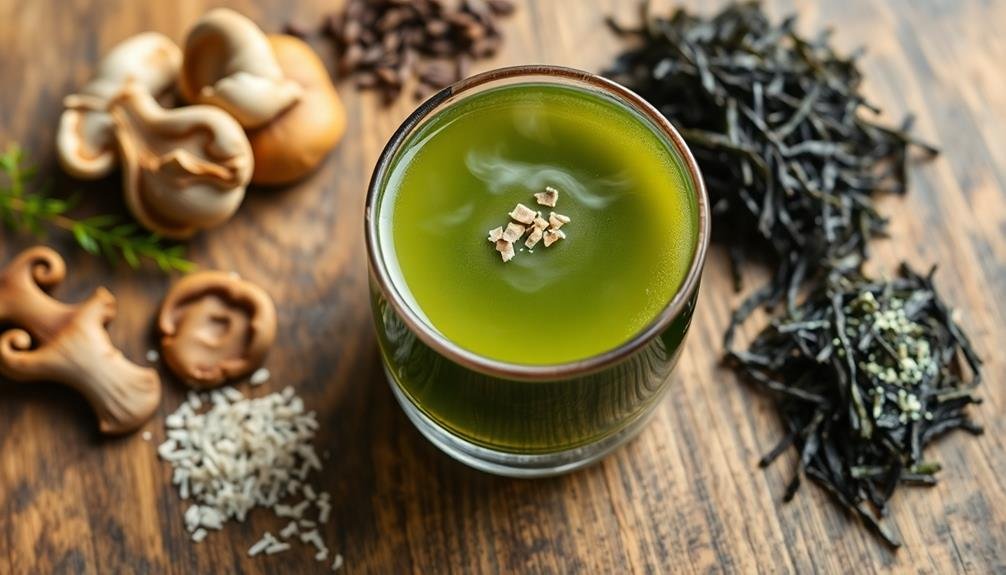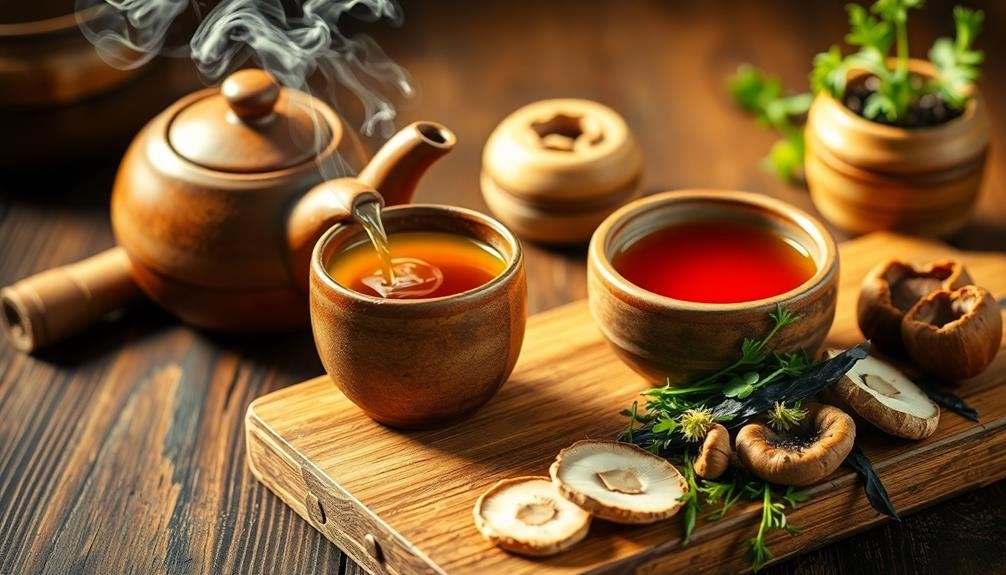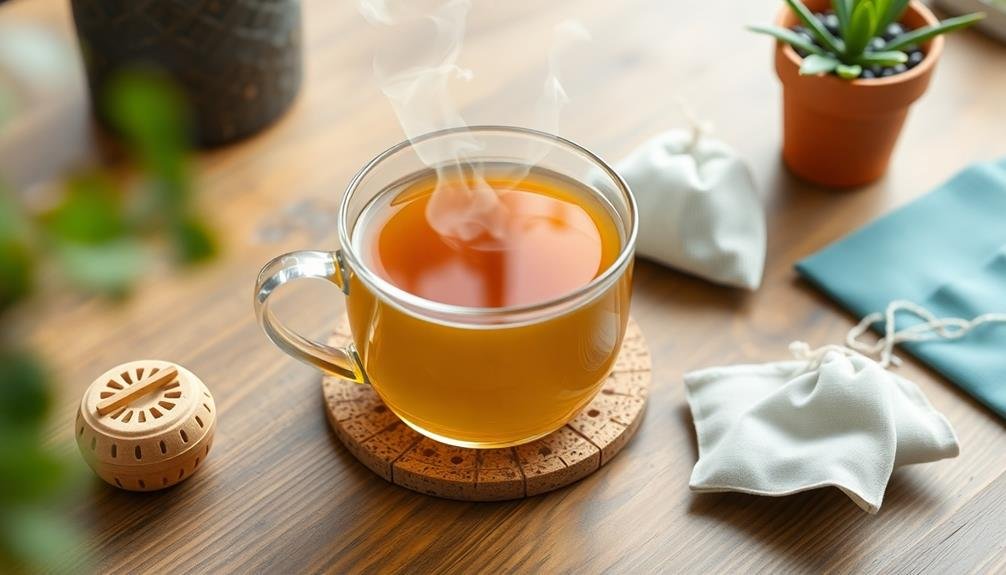Exploring umami flavors in your herbal teas can revolutionize your tea-drinking experience. This savory "fifth taste" adds depth and complexity to your brews, creating rich, satisfying sips that go beyond traditional sweet and bitter notes. Umami-rich teas offer numerous health benefits, including improved digestion, better blood sugar control, and enhanced nutrient absorption. By incorporating ingredients like seaweed, dried mushrooms, or sun-dried tomatoes, you'll discover new flavor profiles that tantalize your taste buds. Balancing umami with other flavors creates harmonious blends, revealing a universe of creative possibilities. Immerse yourself in the domain of savory teas to unveil a whole new dimension of herbal infusions.
Understanding Umami in Tea

While many tea enthusiasts are familiar with sweet, bitter, and floral notes in their brews, umami often goes unrecognized. This savory, rich taste is the fifth basic flavor, alongside sweet, sour, salty, and bitter. In tea, umami contributes depth and complexity, enhancing the overall drinking experience.
You'll find umami in teas with high levels of amino acids, particularly L-theanine. Green teas, especially shade-grown varieties like gyokuro, are known for their umami characteristics. However, you can also discover umami notes in certain herbal teas, expanding your palate beyond traditional expectations.
To identify umami in your tea, pay attention to a lingering, mouth-coating sensation and a subtle, savory flavor reminiscent of mushrooms or seaweed. It's often described as brothy or meaty, though more delicate in teas.
As you develop your palate, you'll notice how umami interacts with other flavors, creating a more balanced and satisfying cup. Understanding umami in tea allows you to appreciate the nuanced flavors and choose blends that suit your taste preferences.
It's an essential aspect of tea appreciation that can elevate your brewing and tasting experiences.
Health Benefits of Savory Teas
You'll find that savory teas offer more than just unique flavors; they come with impressive health benefits.
These teas can aid in improving your digestion and help control your blood sugar levels.
Additionally, the umami compounds in savory teas may enhance your body's ability to absorb essential nutrients from your diet.
Improved Digestion
Savory herbal teas can be a powerful ally for your digestive system. These umami-rich beverages stimulate the production of digestive enzymes, helping your body break down food more efficiently. By sipping on these teas, you're not only enjoying unique flavors but also supporting your gut health.
The digestive benefits of savory herbal teas are numerous:
- Increased saliva production, aiding in the initial breakdown of food
- Stimulation of stomach acid secretion, improving nutrient absorption
- Reduction of bloating and gas by promoting healthy gut bacteria
- Soothing of the digestive tract, easing discomfort after meals
- Enhanced liver function, supporting detoxification processes
You'll find that incorporating savory teas into your routine can lead to smoother digestion and better overall gut health.
The compounds in these teas, such as bitter herbs and mineral-rich plants, work synergistically to support your digestive system. By choosing savory herbal teas, you're not just quenching your thirst; you're actively promoting better digestion and nutrient absorption.
Blood Sugar Control
Beyond their digestive benefits, savory herbal teas can play an essential role in managing blood sugar levels. When you incorporate umami-rich herbs into your tea routine, you're tapping into natural compounds that may help regulate glucose metabolism. Herbs like fenugreek, gymnema sylvestre, and bitter melon have shown promising results in stabilizing blood sugar.
These savory teas can slow down the absorption of sugar in your bloodstream, potentially reducing spikes after meals. They may also improve insulin sensitivity, helping your body use glucose more effectively. By drinking these teas regularly, you could see a gradual improvement in your overall blood sugar control.
It's important to note that while these teas can be beneficial, they're not a substitute for medical treatment. If you have diabetes or pre-diabetes, always consult your healthcare provider before making significant changes to your diet or wellness routine.
You can integrate savory herbal teas as part of a holistic approach to blood sugar management, alongside a balanced diet and regular exercise. Remember, consistency is key – make these teas a regular part of your daily routine for the best potential results.
Increased Nutrient Absorption
While savory herbal teas can help manage blood sugar, they also offer another significant health benefit: increased nutrient absorption.
When you drink umami-rich herbal teas, you're enhancing your body's ability to absorb essential nutrients from the foods you eat. This is due to the presence of certain compounds in savory teas that stimulate digestive processes and improve overall gut health.
The umami flavor in these teas can:
- Increase saliva production, aiding in initial digestion
- Stimulate the release of digestive enzymes
- Enhance the absorption of minerals like iron and zinc
- Promote the growth of beneficial gut bacteria
- Improve overall nutrient utilization
Balancing Umami With Other Flavors

You'll find that balancing umami with other flavors in herbal teas creates intriguing taste experiences.
Try combining savory elements with sweet notes for a harmonious blend, or experiment with umami-citrus pairings to add brightness to your brew.
For a creative twist, explore herbal-umami fusion concepts that merge earthy, savory tastes with traditional herbal tea ingredients.
Savory-Sweet Flavor Harmonies
Although umami is often associated with savory dishes, it can play an essential role in creating balanced and complex herbal tea blends.
When you're exploring umami flavors in your herbal teas, don't overlook the potential for savory-sweet harmonies. These combinations can elevate your tea experience, offering a unique and sophisticated flavor profile.
To create savory-sweet harmonies in your herbal teas, consider pairing umami-rich ingredients with naturally sweet herbs or fruits. This balance can result in a well-rounded, satisfying sip that engages multiple taste receptors.
Here are some ingredients to experiment with:
- Roasted dandelion root with honey
- Dried shiitake mushrooms with licorice root
- Kombu seaweed with apple pieces
- Miso powder with chamomile flowers
- Toasted nori flakes with dried berries
Umami-Citrus Pairing Techniques
Pairing umami with citrus flavors adds another dimension to herbal tea blending. You'll find that the savory depth of umami complements the bright, tangy notes of citrus, creating a complex and satisfying flavor profile.
To achieve this balance, start with a base of umami-rich ingredients like dried mushrooms, seaweed, or roasted grains. Then, introduce citrus elements such as lemon peel, orange zest, or dried citrus fruits.
When combining these flavors, reflect on the intensity of each component. A strong umami base might require a bolder citrus presence, while a subtle umami undertone can be enhanced by delicate citrus notes. You can also experiment with different citrus varieties to find the perfect match for your umami ingredients.
For example, try pairing earthy shiitake mushrooms with zesty yuzu, or combine roasted barley with sweet mandarin orange.
Don't forget to reflect on the overall mouthfeel of your blend. The umami components often provide a full-bodied texture, while citrus can add an invigorating lightness.
Herbal-Umami Fusion Concepts
How can herbalists create innovative tea blends that showcase umami's savory depth while harmonizing with other flavors? The key lies in understanding umami's unique characteristics and how they interact with various herbal notes.
You'll want to experiment with combinations that balance umami's richness with complementary or contrasting elements.
Consider these fusion concepts to elevate your herbal-umami tea blends:
- Pair umami-rich herbs like nettle or mushroom with bright, citrusy notes
- Combine savory seaweed with sweet and floral elements like chamomile
- Enhance umami depth with roasted flavors such as dandelion root or chicory
- Balance umami's intensity with cooling herbs like peppermint or spearmint
- Incorporate earthy spices like turmeric or ginger to complement umami's complexity
When crafting these blends, pay attention to the intensity of each component.
You'll need to adjust proportions carefully to guarantee umami doesn't overpower other flavors.
Start with small amounts of umami-rich ingredients and gradually increase until you achieve the desired balance.
Don't be afraid to push boundaries and create unexpected combinations.
Ingredients for Umami-Rich Herbal Teas
Exploring the world of umami-rich herbal teas opens up a domain of intriguing ingredients. You'll find that certain herbs and plants naturally contain compounds that contribute to the savory, umami taste.
Seaweed, particularly kombu and nori, is an excellent source of glutamates, which are responsible for the umami flavor. When brewing, you can add small pieces of dried seaweed to your tea blend for a subtle oceanic umami note.
Mushrooms are another potent umami ingredient. Dried shiitake, porcini, or reishi mushrooms can be ground into a fine powder and incorporated into your herbal tea mix. They'll impart a rich, earthy flavor that complements other herbs beautifully.
Don't overlook tomatoes either; sun-dried tomatoes, when finely chopped, can add a delightful umami kick to your brew.
For a more unconventional approach, consider adding a pinch of miso paste or nutritional yeast to your tea. These ingredients are packed with umami-enhancing compounds and can transform your herbal infusion into a savory delight.
Brewing Techniques for Savory Blends

Now that you've gathered your umami-rich ingredients, it's time to master the art of brewing these savory blends. The key to revealing the full potential of umami flavors in your herbal teas lies in the brewing process. Start by using filtered water to guarantee a clean base for your brew. Heat the water to just below boiling, around 195°F (90°C), as excessive heat can lead to bitterness.
For peak extraction, follow these brewing techniques:
- Steep for longer periods, typically 5-7 minutes, to fully release the savory compounds
- Use a slightly higher ratio of herbs to water than you'd for traditional teas
- Experiment with cold brewing for a smoother, less astringent flavor profile
- Try multiple steepings to explore the evolving taste of your blend
- Consider adding a pinch of salt to enhance the umami notes
As you brew, pay attention to the color and aroma of your tea. A rich, deep hue and a savory scent indicate that you're on the right track.
Don't be afraid to adjust steeping times and ratios to suit your taste preferences. With practice, you'll develop an intuition for crafting the perfect umami-rich herbal tea.
Pairing Umami Teas With Food
The art of pairing umami teas with food can elevate your dining experience to new heights. When selecting a savory herbal tea to complement your meal, consider the dominant flavors in your dish. For example, pair a roasted seaweed tea with sushi or seafood to enhance the briny notes.
A mushroom-based tea can complement earthy dishes like risotto or roasted vegetables.
Don't be afraid to experiment with contrasting flavors. A miso-infused tea can provide a delightful counterpoint to sweet desserts, while a smoky lapsang souchong can balance rich, fatty foods like grilled meats.
For Asian cuisine, try pairing a kombu-based tea with noodle dishes or dumplings to amplify the umami flavors.
Remember that temperature plays a role in pairing. Hot teas work well with warm dishes, while iced umami teas can be invigorating alongside cold salads or chilled appetizers.
Pay attention to the intensity of both the tea and the food – you don't want one to overpower the other. By carefully considering these factors, you'll create harmonious pairings that enhance both the tea and the meal.
Frequently Asked Questions
Can Umami Teas Replace Traditional Savory Snacks?
You can use umami teas as a satisfying alternative to traditional savory snacks. They offer a rich, savory flavor profile that can curb cravings. However, they won't provide the same texture or fullness as solid snacks.
Are There Any Umami Tea Traditions in Different Cultures?
You'll find umami tea traditions in various cultures. Japan's kombucha (kelp tea) and China's pu-erh tea are prime examples. Korea's roasted corn tea and Tibet's butter tea also offer savory, umami-rich experiences you can explore.
How Do Umami Teas Affect Caffeine Sensitivity?
You'll find that umami teas don't directly affect caffeine sensitivity. They're often caffeine-free, like herbal blends. If you're sensitive to caffeine, you can enjoy umami teas without worry. They're a great alternative to caffeinated beverages.
Can Children Safely Consume Umami-Flavored Herbal Teas?
Yes, children can safely enjoy umami-flavored herbal teas. They're caffeine-free and offer unique flavors. However, you should always check ingredients for potential allergens and consult your pediatrician if you have concerns about introducing new foods or beverages.
Are There Specific Tea Accessories Best Suited for Umami Teas?
You'll find that traditional Japanese tea accessories work well for umami teas. Consider using a kyusu teapot, yunomi cups, or a matcha bowl and whisk. These tools enhance the flavor and experience of umami-rich teas.
In Summary
You've now explored the world of umami in herbal teas, from understanding its essence to crafting perfect blends. Don't be afraid to experiment with savory ingredients and brewing techniques. You'll discover new dimensions of flavor and potential health benefits. Remember to balance umami with other tastes and consider food pairings. By embracing these savory notes, you're expanding your tea experience and revealing a whole new domain of enjoyment in your daily cup.





Leave a Reply